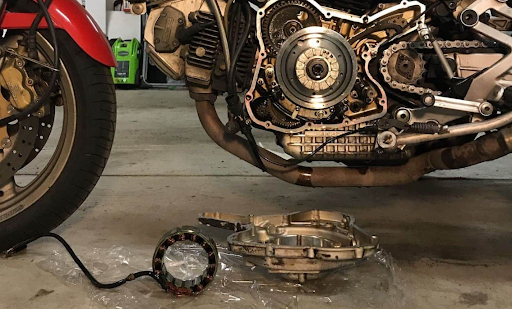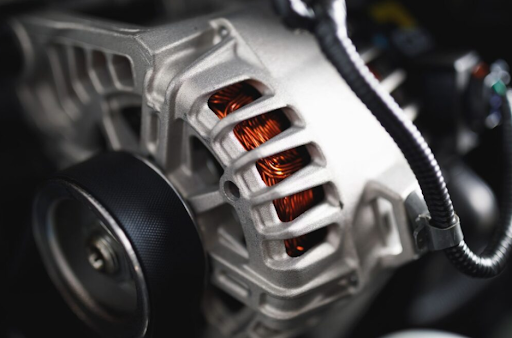6 minute read
Hard starts, dimming lights, and dead batteries are just a few signs that your motorcycle may have a faulty voltage regulator. This essential electrical component converts AC power generated by the alternator into usable DC power. It also keeps voltage within a defined range, preventing electrical surges and overheating that can fry bike parts in seconds. If you’re experiencing related issues, such as a jolty throttle, fluctuating meter readings, or problems with the indicators, it might be time to check whether the regulator is at fault.
Charging System and Voltage Regulator Basics
Understanding motorcycle charging systems is one way to ensure a smooth and trouble-free ride. There are three basic parts to consider: the battery, the alternator, and the voltage regulator. The battery stores necessary power, supplies power to starter motors to get the bike going, and powers electrical systems when the alternator isn’t providing the right output. It also acts as a buffer, preventing high alternator current and electrical surges from damaging the bike and its sensitive electrical systems.
The alternator generates alternating current (AC) to run the bike and charge the battery. While larger, self-contained car-like alternators feature on the biggest bikes, most motorcycles use a three-piece setup consisting of a separate rotor, stator, and regulator/rectifier. This arrangement simplifies maintenance. Rotors and stators produce AC power through electromagnetism, while the voltage regulator for motorcycle converts this to direct current (DC) so it can be stored in the battery. The regulator also monitors incoming current, ensuring it doesn’t exceed 15V, which could damage the battery or the bike’s electrical system.
How Do Voltage Regulator Rectifiers Work?
Most motorcycles have a three-phase charging system, with three wires connecting the stator and regulator rectifier. The component first transforms (or rectifies) alternating current into pulsating DC using semiconductors or diodes, then regulates it to a constant voltage not exceeding 14.5V. This is achieved with sensing elements and thyristors (essentially ON/OFF switches) that turn current from the alternator and stator on or off based on a reference voltage (or regulation point). The regulated current is then fed back into the battery.
Smaller displacement machines may have a single-phase regulator rectifier with two wires instead of three, but they work on the same principle as three-phase systems. The latter are more efficient but also more costly.
Common Types
The type of voltage regulator for a motorcycle depends on the type of alternator. These fall into two categories. Permanent magnet rotor (PMR) types have permanent magnets that revolve with the engine and within (or wound around) a set of coils—the stator. Most are of the three-phase type.
Field control type (FCT) alternators replace magnets with field coils. Newer brushless variants with stationary field and phase coils and rotors spinning inside feature in current motorcycle models. Older bikes have brushed coil alternators and regulators.
Can Regulator Rectifiers Fail?
While charging system components in well-built motorcycles can last over 20 years without issue, heat is the biggest killer of regulator rectifiers. That’s why they’re usually located in areas with good airflow. Despite integrated heat sinks (in the form of metal fins) to dissipate heat, regulators can also fail due to loose or corroded wiring connections, poor grounding, or dead batteries. If the component can’t perform its main task—transforming alternating current into usable DC power—you’ll start noticing typical signs:
- Engine and/or battery light comes on: Tthe first signs of a failing regulator rectifier can be seen on the dash. Battery lights can indicate an issue with the rectifier diodes or bad sensing elements. Engine lights come on when ECUs register changes in power supply to crucial engine systems like the ignition.
- Overheating battery and regulators: Overly hot batteries are a sign that the regulator section has failed leading to overcurrent and voltage spikes. If not caught on time, you risk permanent battery damage.
- Dimming lights: Headlights, tail lights and indicators that get dimmer over time point to a bad unit that can’t fully charge the battery.
- Failing electrics: TFT displays, radios, heat grips and other electrics can act up or not work at all. This is a sign either of a failing battery, or one that isn’t getting enough charge due to a bad part.
- Performance and starting issues: The same issues can extend to major engine parts and systems, most notably the fuel injection and ignition. If you notice abrupt performance changes or gradual power loss, check that the regulator is supplying enough voltage. Poor acceleration, stuttering, stalling or even failing to start the bike can all be because of a bad regulator.
- Dead or failing batteries: This happens when motorcycle regulator problems are caught too late. Batteries can be fed too little current, leading to gradual depletion, or overcurrent, risking swelling and explosions.
Diagnosing Faults
Use a multimeter set to DC voltage to determine whether your bike’s regulator is in working condition. This measures voltages across the battery terminals. With the engine idling, readouts should be between 13.5 and 14V. Rev the engine. Readouts of 14.2V indicate no issues with the regulator rectifier and show that the battery is charging. Alternatively, readings above 14.5V indicate overvoltage and the risk of damaging the battery and all electrics. Similarly, a readout below 12V also means a faulty unit. A replacement is often the only fix.
Additionally, check for loose, corroded, or discoloured connections, the AC supply in the alternator, or use a temperature gun to locate excessive heat. Also, check the owner’s manual for reference voltages and specific testing procedures (such as ensuring diodes are working).
Lastly, if problems persist despite readouts being within defined ranges, have the bike inspected by a professional. Electrical and charging issues can be difficult to pinpoint and are often interdependent. This is where a pro can help.
Finding Replacements
Regulator rectifiers may be simple parts, but they perform a vital role in your bike’s operation. A failed unit means electrical problems like dimming lights, performance issues such as a choppy throttle, or even difficulty getting the bike started. Waiting too long for a replacement can also mean dying batteries or problems spreading elsewhere.
Replacements are easy to find. Ensure you get a regulator rectifier for your exact make, model, trim, and production year. This is due to the varying power needs of different bikes. Look for well-built (and stylish) parts from OE manufacturers or aftermarket bike specialists to get a part and a bike that works and lasts.






